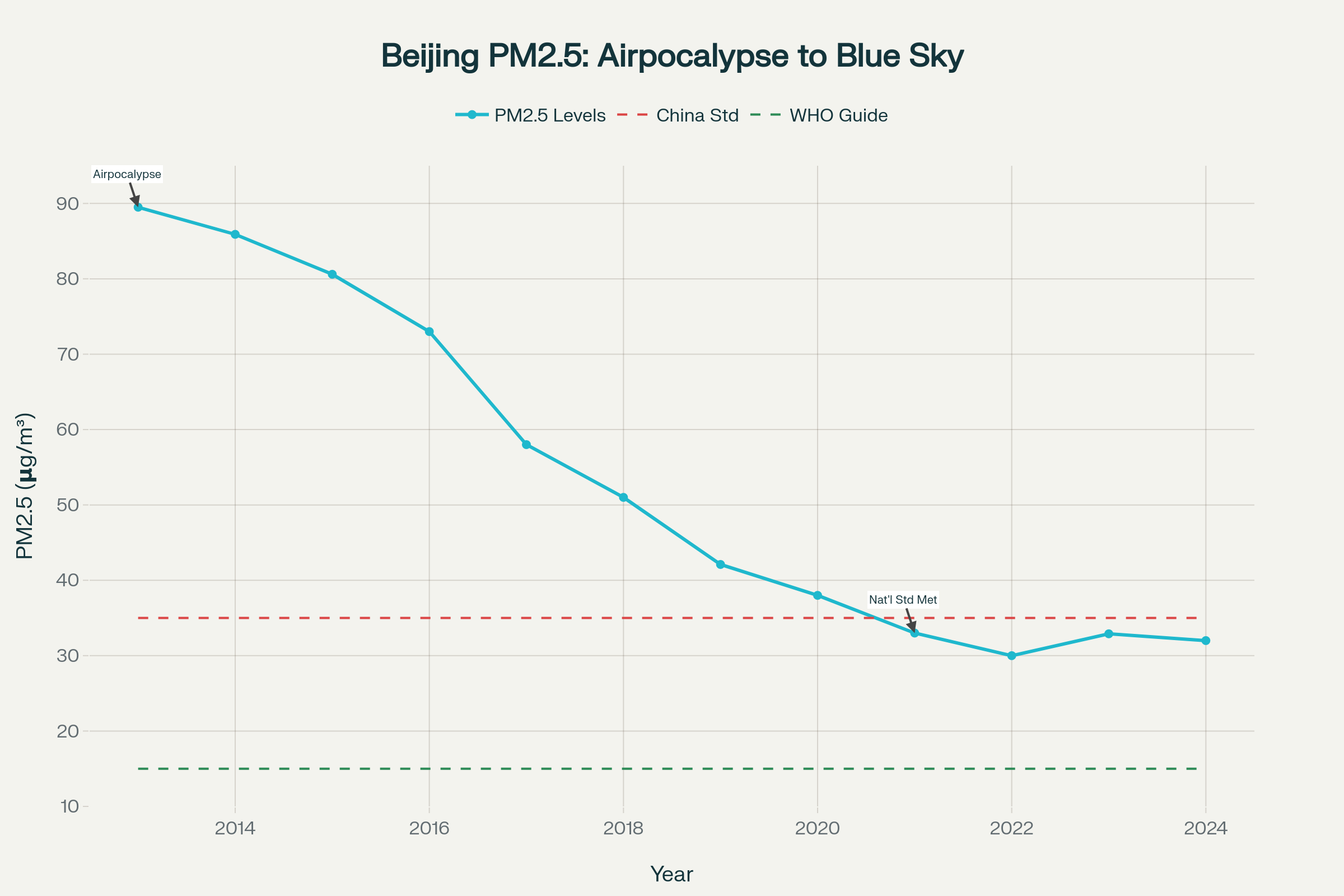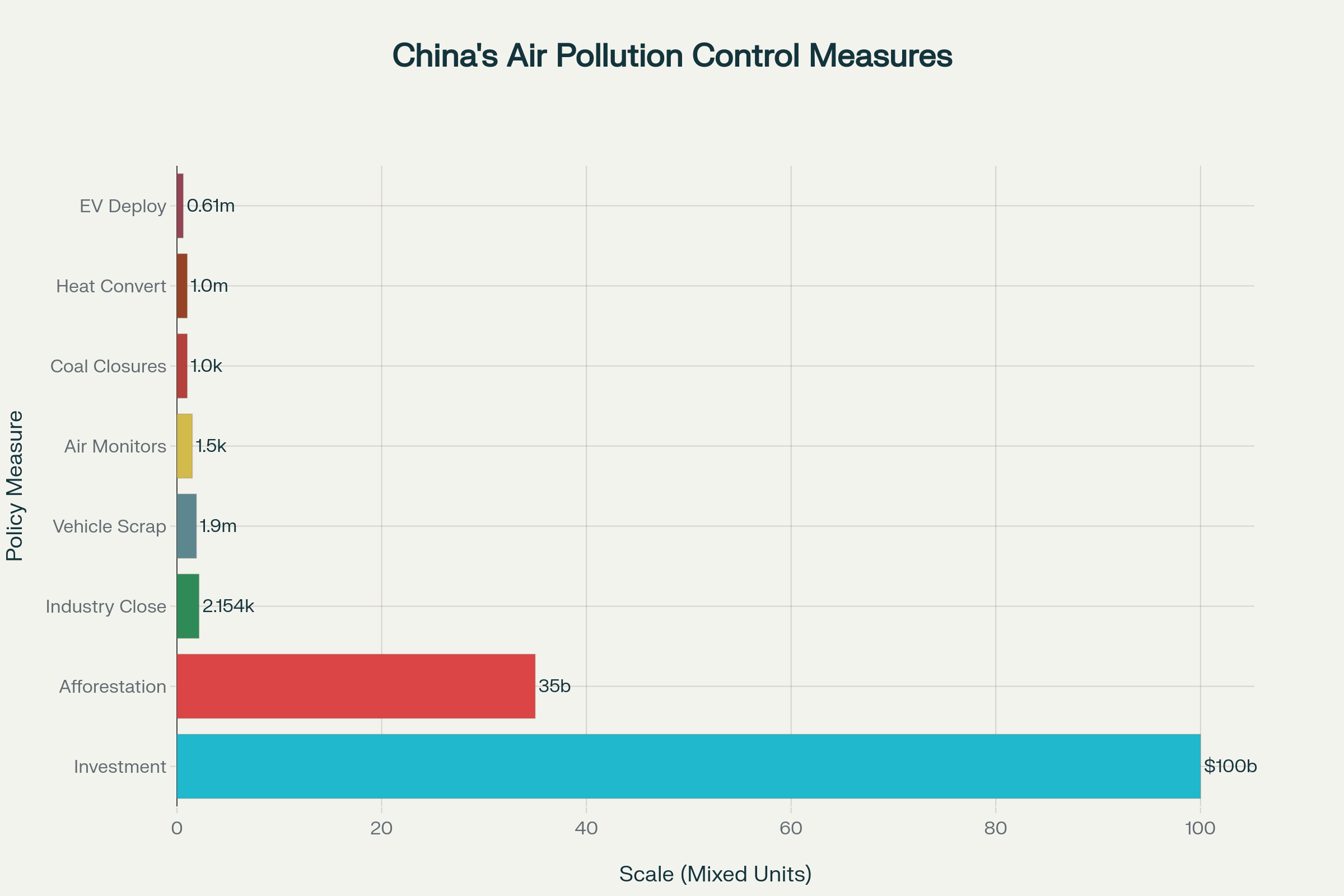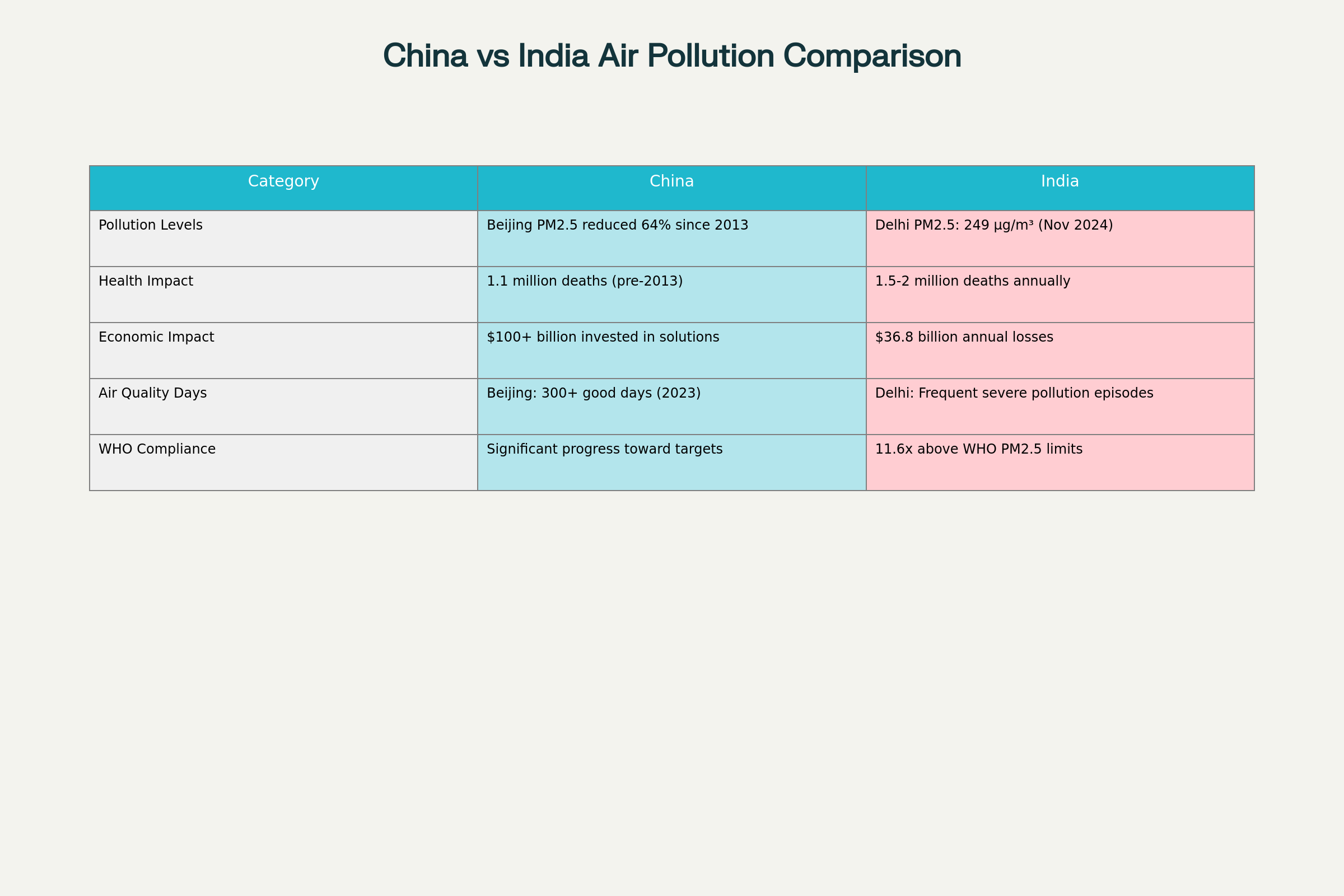Key Highlights
- China extends pollution control cooperation offer to India as Delhi records PM2.5 levels of 249 µg/m³, exceeding WHO guidelines by 1,560% in November 2024
- Beijing achieved remarkable 64% PM2.5 reduction since 2013 through systematic policy implementation and $100 billion investment in comprehensive solutions
- China extends pollution control technology transfer programs globally, with over 300 international clean air technologies assessed through collaborative initiatives
Opening Overview
China extends pollution control expertise to India through a strategic diplomatic initiative announced by Chinese Embassy spokesperson Yu Jing amid Delhi’s severe air quality crisis that has persisted throughout November 2024. The offer comes as China extends pollution control knowledge gained from transforming Beijing’s air quality from severe pollution levels exceeding 89.5 µg/m³ in 2013 to meeting national standards at 33 µg/m³ by 2021.
Delhi’s current PM2.5 concentrations of 249 µg/m³ represent a critical environmental emergency that mirrors China’s 2013 ‘airpocalypse’ situation, creating an opportune moment for China extends pollution control cooperation between the two nations. The Chinese government’s systematic approach involved comprehensive policy reforms, massive industrial restructuring, and unprecedented financial commitments that demonstrate how China extends pollution control solutions beyond traditional environmental measures.
With India facing 1.5-2 million annual deaths from air pollution and economic losses of $36.8 billion annually, the timing of how China extends pollution control expertise represents a critical opportunity for bilateral environmental cooperation. The initiative builds upon existing India-China climate cooperation frameworks established in 2009, where both nations agreed to strengthen collaboration on climate change mitigation and pollution control technologies.
Beijing’s Revolutionary Air Quality Transformation Strategy
- China extends pollution control measures through the landmark Air Pollution Action Plan of 2013, establishing the world’s most comprehensive environmental policy framework
- Beijing’s PM2.5 levels dropped from 89.5 µg/m³ in 2013 to 33 µg/m³ by 2021, representing a 63% reduction and meeting national standards for the first time
- China extends pollution control monitoring through over 1,500 air quality monitoring stations nationwide, enabling real-time enforcement and policy adjustments3.amazonaws
China extends pollution control success through Beijing’s transformation that began following the devastating 2013 ‘airpocalypse’ when PM2.5 levels reached hazardous concentrations exceeding 89.5 µg/m³. The comprehensive Air Pollution Action Plan launched in September 2013 demonstrated how China extends pollution control beyond traditional approaches by establishing stringent targets for PM2.5 reduction across major metropolitan regions including Beijing-Tianjin-Hebei. Beijing’s remarkable progress is evidenced through consistent annual improvements, with PM2.5 concentrations dropping to 58 µg/m³ by 2017, 33 µg/m³ by 2021, and stabilizing around 32 µg/m³ by 2024.
The strategy involved systematic closure of over 1,000 coal-fired power plants and implementation of strict vehicle emission standards that removed 1.9 million high-polluting vehicles from roads. China extends pollution control effectiveness through massive afforestation programs that planted over 35 billion trees across 12 provinces, with forestry expenditure per hectare exceeding US and European levels by three times the global average.
The success continued with the 2018 Three-Year Action Plan for Winning the Blue Sky War, which expanded China extends pollution control measures to all 231 cities and mandated 18% PM2.5 reduction targets nationwide. Advanced monitoring systems now encompass over 1,500 air quality monitoring stations that provide real-time data and prevent local manipulation, ensuring that China extends pollution control policies achieve measurable environmental outcomes.

Beijing’s PM2.5 Transformation: From Airpocalypse to Blue Sky (2013-2024)
India’s Critical Air Pollution Emergency and Health Crisis
- Delhi recorded PM2.5 concentrations of 249 µg/m³ in November 2024, exceeding WHO guidelines by 1,560% and national standards by 314%
- Air pollution causes 1.5-2 million premature deaths annually in India, representing the world’s largest pollution-related mortality burden
- Economic losses from air pollution reach $36.8 billion annually, equivalent to 1.36% of India’s GDP and threatening long-term development goals
India’s air pollution crisis has escalated to emergency levels, with Delhi recording some of the world’s most dangerous air quality readings throughout November 2024. The national capital’s PM2.5 concentrations averaged 249 µg/m³ in November 2024, which is 1,560% above WHO guidelines of 15 µg/m³ and 314% above India’s national ambient air quality standards of 60 µg/m³.
The Air Quality Index consistently remained above 300 in the ‘very poor’ category, with multiple monitoring stations recording ‘severe’ levels exceeding 400, creating hazardous conditions equivalent to smoking 7 cigarettes daily. The human toll of India’s air pollution emergency is devastating, with recent Lancet studies confirming that air pollution causes between 1.5 to 2 million premature deaths annually across the country.
China once struggled with severe smog, too.
— Yu Jing (@ChinaSpox_India) November 4, 2025
We stand ready to share our journey toward blue ones—and believe India will get there soon. ☀💙 #CleanAir #TogetherForEarth pic.twitter.com/VJQoa6ap1V
A comprehensive mortality analysis published in 2024 found that long-term exposure to PM2.5 pollution above WHO guidelines is directly associated with 1.67 million deaths per year in India, representing 17.8% of all deaths nationally. The economic impact is equally catastrophic, with air pollution accounting for $36.8 billion in annual economic losses, representing 1.36% of India’s gross domestic product and potentially undermining the country’s aspiration to achieve a $5-trillion economy.
WHO data indicates that India recorded the world’s largest pollution-related death toll in 2019, with air quality deterioration affecting urban areas where over 480 million people are exposed to PM2.5 levels exceeding national standards. Recent studies reveal that air pollution was linked to 15% of all deaths in Delhi during 2023, highlighting the urgent need for comprehensive policy intervention similar to how China extends pollution control measures.
Comprehensive Technology Transfer and Policy Implementation Framework
- China extends pollution control through international programs like the Bluetech Award, assessing over 300 clean air technologies from 20+ countries since 2015
- Industrial transformation included closing 2,154 polluting enterprises and converting 1 million rural households from coal to clean heating systems
- China extends pollution control investment of over $100 billion demonstrates unprecedented government commitment to systematic environmental restorations3.amazonaws
China extends pollution control expertise through comprehensive technology transfer initiatives and systematic policy implementation that addresses all major sources of atmospheric contamination. The Bluetech Clean Air Alliance Award program demonstrates how China extends pollution control internationally by assessing over 300 advanced technologies from more than 20 countries since 2015, focusing on monitoring, ultra-low emission control, and volatile organic compound reduction. China extends pollution control domestically through massive industrial restructuring that involved closing 2,154 polluting enterprises, retrofitting coal-fired power plants, and phasing out 1.9 million heavy-duty diesel vehicles that failed emission standards.
The residential heating transformation exemplifies how China extends pollution control to all sectors, with Beijing transitioning all urban areas and over 1 million rural households from coal to electric or gas heating systems between 2013-2022. Transportation sector reforms included deploying 610,000 electric vehicles and implementing strict emission standards that significantly reduced vehicular pollution in major cities. China extends pollution control through advanced monitoring systems utilizing AI, Internet of Things (IoT), and big data analytics to enhance environmental oversight, with the Ministry of Ecology and Environment operating a national network covering over 1,500 monitoring sites.
The afforestation component represents how China extends pollution control beyond industrial measures, with the Great Green Wall project planting over 35 billion trees across 12 provinces at a cost exceeding $100 billion in forestry expenditure. Health outcomes demonstrate the effectiveness of how China extends pollution control, with estimated premature deaths in the Beijing-Tianjin-Hebei region attributable to short-term PM2.5 exposure decreasing from 24,700 in 2013 to 13,500 by 2020.

China’s Comprehensive Air Pollution Control Measures: Scale and Impact
Strategic Bilateral Cooperation and Future Environmental Partnership
- China extends pollution control cooperation through existing India-China climate agreements established in 2009, providing institutional framework for technology transfer
- Successful implementation requires coordinated multi-sectoral action across energy, transportation, industrial policy, and urban planning sectors
- China extends pollution control expertise globally while demonstrating how environmental cooperation can enhance diplomatic relationships between major economiess3.amazonaws
China extends pollution control cooperation to India builds upon established bilateral frameworks including the India-China Partnership on Combating Climate Change and the Working Group on Climate Change that facilitate regular ministerial consultations and technology exchange. The existing agreement framework demonstrates how China extends pollution control collaboration through joint research and development activities, capacity building programs, and personnel exchange initiatives focused on energy efficiency, renewable energy, and clean technologies.
China extends pollution control success internationally through programs like the Beautiful China 2025 initiative, which leverages artificial intelligence, carbon capture technologies, and smart environmental monitoring systems that can be adapted for Indian urban contexts. The strategic implications of how China extends pollution control expertise encompass broader diplomatic and economic cooperation opportunities, particularly given both nations’ shared challenges with population density and industrial development.
China extends pollution control technology transfer through established mechanisms including the Bluetech Award program, which provides intellectual property capacity building, real-world technology demonstration, and matchmaking with potential business partners and investors. Successful implementation requires sustained political commitment and substantial financial investment, with China’s experience demonstrating how China extends pollution control requires coordinated action across multiple sectors including energy policy, transportation planning, and industrial regulation.
The potential for technology transfer in electric vehicle deployment, renewable energy integration, and advanced air quality monitoring systems illustrates how China extends pollution control solutions can accelerate India’s transition to cleaner urban environments. International environmental cooperation demonstrates how China extends pollution control expertise creates opportunities for diplomatic engagement and mutual learning, potentially contributing to broader bilateral relationship improvements and regional stability.

China-India Air Pollution Comparison: Key Metrics and Outcomes
Final Assessment and Implementation Pathways
China extends pollution control expertise to India at a critical juncture when Delhi’s air quality crisis demands immediate and comprehensive policy intervention, with November 2024 PM2.5 levels of 249 µg/m³ representing a public health emergency requiring systematic solutions. The remarkable success of how China extends pollution control is demonstrated through Beijing’s 64% PM2.5 reduction since 2013, achieved through over $100 billion in strategic investments, comprehensive industrial restructuring, and advanced monitoring systems that provide a proven blueprint for addressing severe urban air pollution.
China extends pollution control methodology through multi-sectoral coordination involving energy transformation, transportation electrification, industrial emission controls, and massive afforestation programs that collectively address all major sources of atmospheric contamination. The health implications underscore the urgency of how China extends pollution control expertise could benefit India, where air pollution causes 1.5-2 million annual deaths compared to China’s significant reduction in pollution-related mortality following comprehensive policy implementation.
The economic dimensions reveal how China extends pollution control investment of $100 billion generated substantial returns through reduced healthcare costs, improved productivity, and enhanced quality of life, offering valuable lessons for India’s economic development strategy. China extends pollution control success through systematic enforcement mechanisms, advanced monitoring technologies, and sustained political commitment that maintained consistent policy focus across multiple planning cycles, demonstrating the institutional requirements for effective environmental governance.
The diplomatic significance of how China extends pollution control cooperation creates constructive avenues for bilateral engagement on shared global challenges, potentially strengthening regional stability while advancing sustainable development goals for both nations. The proven effectiveness of how China extends pollution control through international technology transfer programs and bilateral cooperation frameworks provides institutional mechanisms for implementing comprehensive environmental solutions that can be adapted to India’s specific urban and industrial contexts.


